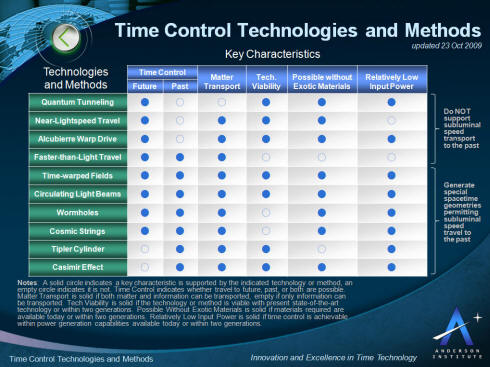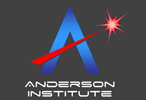Time Control Technologies and Methods
An overview by
Dr. David Lewis Anderson
The ability to control time in both a forward
and backwards direction is possible within the laws of our
mathematics and physics. The chart below (click
for larger view) compares ten different technologies an
methods. Key characteristics are identified for each and
described below.

Under each key characteristic is a column with either a solid or
empty circle. A solid circle indicates a key characteristic is
supported by the indicated technology or method, an empty circle
indicates it is not.
"Time Control" indicates whether travel to future, past, or both
are possible. "Matter Transport" is solid if both matter and
information can be transported, empty if only information can be
transported. "Tech Viability" is solid if the technology or
method is viable with present state-of-the-art technology or
within two generations. "Possible Without Exotic Materials" is
solid if materials required are available today or within two
generations. "Relatively Low Input Power" is solid if time
control is achievable within power generation capabilities
available today or within two generations.
The time control technologies and methods above include the following:
 |
|
Quantum Tunneling:
is an evanescent wave coupling effect that occurs in
quantum mechanics. The correct wavelength combined with
the proper tunneling barrier makes it possible to pass
signals faster than light, backwards in time.
 |
|
|
|
 |
|
Near-Lightspeed Travel:
has the ability to significantly dilate time, sending an
accelerating traveler rapidly forward in time relative
to those left behind before her travel. The closer to
the speed of light, the further into the future the
travel.
 |
| |
|
|
 |
|
Alcubierre Warp Drive:
stretches spacetime in a wave causing the fabric of
space ahead of a spacecraft to contract and the space
behind it to expand. The ship can ride the wave to
accelerate to high speeds and time travel.
 |
| |
|
|
 |
|
Faster-than-Light Travel:
is a controversial subject. According to special
relativity anything that could travel faster-than-light
would move backward in time. As the same time, special
relativity states that this would require infinite
energy.
 |
| |
|
|
 |
|
Time-warped Fields:
use energy within curvatures of spacetime around a
rotating mass or energy field to generate containable
and controllable fields of closed-timelike curves that
can move matter and information forward or backward in
time.
 |
| |
|
|
 |
|
Circulating
Light Beams:
can be created using gamma and magnetic fields to warp
time. The approach can twist space that causes
time to be twisted, meaning you could theoretically walk
through time as you walk through space.
 |
| |
|
|
 |
|
Wormholes: are
hypothetical areas of warped spacetime with great energy
that can create tunnels through spacetime. if
traversable would allow a traveler to quickly move
through great distances in space and also travel through
time.
 |
| |
|
|
 |
|
Cosmic Strings:
are a hypothetical 1-dimensional (spatially) topological
defect in the fabric of spacetime left over from the
formation of the universe. Interaction could create
fields of closed timelike curves permitting backwards
time travel.
 |
| |
|
|
 |
|
Tipler Cylinder:
uses a massive and long cylinder spinning around its
longitudinal axis. The rotation creates a frame-dragging
effect and fields of closed timelike curves traversable
in a way to achieve subluminal time travel to the past.
 |
| |
|
|
 |
|
Casimir Effect: a
physical force arising from a quantized field, for
example between two uncharged plates. This can produce a
locally mass-negative region of space-time that could
stabilize a wormhole to allow faster than light travel.
 |
|
|
|












